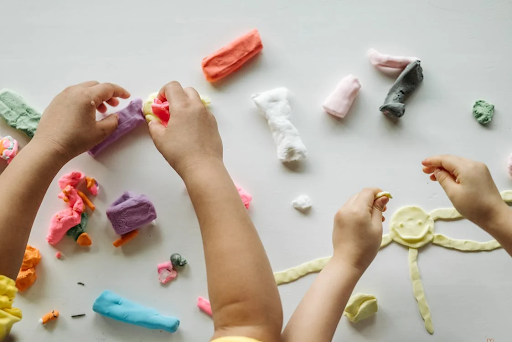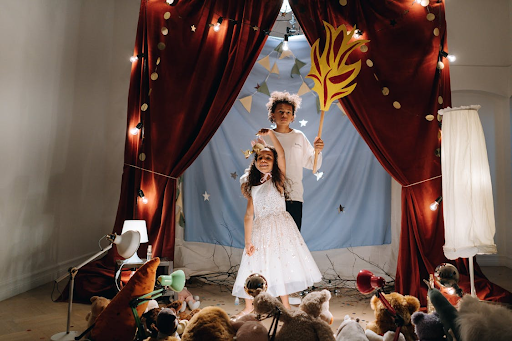 One educational approach that happens to engage more than one sense at a time is multisensory learning. It may be done through any integration of visual, auditory, tactile, olfactory, and gustatory experiences meant to reinforce learning. Examples include learning the alphabet by singing songs (auditory), with flashcards (visual), or while tracing letters in sand (tactile). In this way, the method does make learning more vivid, dynamic, and effective.
One educational approach that happens to engage more than one sense at a time is multisensory learning. It may be done through any integration of visual, auditory, tactile, olfactory, and gustatory experiences meant to reinforce learning. Examples include learning the alphabet by singing songs (auditory), with flashcards (visual), or while tracing letters in sand (tactile). In this way, the method does make learning more vivid, dynamic, and effective.
The first few years of childhood typically represent the most crucial for cognitive, social, and emotional development. Children at this age easily absorb new experiences. Through multisensory learning, their exposures not only improve a child’s brain development but also help them concentrate more and get a better understanding of various concepts. Such a learning strategy will also cater to different styles and provide equal opportunities for every child to thrive. Early childhood education forms a foundation for lifetime learning, and thus, techniques need to be applied to reach out to the needs of young learners.
What is Multisensory Learning?
Multisensory learning is the approach to teaching that involves using several senses together at a time—sight, sound, touch, taste, and smell—to maximize the experience of learning. This was developed as an educational approach meant to increase the effectiveness of teaching methods without using traditional techniques but by introducing activities that will stimulate various sensory pathways. For example, when teaching the different seasons, the activities will include viewing pictures of the colourful leaves of autumn (visual), hearing the sounds of the rustling leaves (auditory), feeling actual leaves (tactile), smelling pine cones (olfactory), and tasting fruits available during that season (gustatory).
Engaging multiple senses activates different areas of the brain, facilitating better understanding and retention of information. It also helps cater to diverse learning styles, whether a child learns best through seeing, hearing, or doing. This holistic approach not only makes learning more engaging but also supports cognitive development by creating strong neural connections. When children experience concepts through various senses, they are more likely to grasp complex ideas and remember them over time. This inclusive method ensures that every child has the opportunity to thrive, making education a more accessible and enjoyable journey.
The Role of Multisensory Education in Early Childhood Development
Cognitive Development
Multisensory education plays a crucial role in cognitive development by engaging multiple brain areas simultaneously. This approach enhances neural connections, promoting better problem-solving abilities and critical thinking skills. Activities like sensory play can stimulate curiosity and creativity, laying a strong foundation for future learning.
Emotional and Social Benefits
Multisensory activities help children develop emotional and social skills. Such experience boosts self-esteem as a child learns to interact with others effectively in their environment. Fun activities also teach teamwork and communication. They encourage children to work collectively, share, and understand different perspectives.
Enhancing Memory and Retention
Any learning style that utilizes multiple senses significantly improves memory retention. Most children learn better and remember things longer if they have an association with something they can see, hear, or feel. Such multiple senses improve memory for a long time because the multisensory involvement makes the impressions last longer, leading to easier and more efficient recall. This multisensory engagement creates lasting impressions, making recall easier and more effective.
Supporting Different Learning Styles
Every child learns differently. They are either a visual, or an auditory, or a kinesthetic learner. Multisensory education attempts to accommodate each one of these differences through various learning experiences that enable each individual child to grow in their strengths. Such a policy of inclusiveness makes education accessible and enjoyable for every child and increases their potential to be successful.
Benefits of Multisensory Learning
Improved Cognitive Skills
Multisensory learning boosts brain development by activating multiple areas simultaneously. This engagement strengthens neural connections, enhancing cognitive functions such as problem-solving and critical thinking. Activities that combine different senses, like using tactile materials to learn math concepts or listening to stories while following along with visuals, stimulate curiosity and creativity. These experiences lay a robust foundation for advanced learning, equipping children with the skills necessary to tackle complex challenges as they grow.
Better Retention and Recall
Engaging multiple senses during learning significantly aids memory retention. When children learn through sight, sound, and touch, the information is more likely to be stored in long-term memory. For instance, using sensory bins to explore letters and numbers helps create vivid, memorable experiences. This multisensory engagement forms strong mental associations, making recall easier and more effective. Over time, these reinforced connections lead to better retention of knowledge, ensuring that children can access and apply what they’ve learned more reliably.
Enhanced Language and Literacy Skills

Building vocabulary through sensory exploration can make language more interesting and effective for a young learner. For example, experiencing assorted textures while naming objects will enhance the ability to connect words with sensations of touch and further solidify learning. Listening to stories while acting them out with props can also enhance comprehension and retention, as children connect spoken words with physical actions.
Multisensory techniques to improve reading and writing skills integrate the aspects of sight, sound, and touch in the learning process. Tracing letters in sand or using magnetic letters on the board makes the process interactive. Reading books with vivid illustrations while listening to the text being read aloud can cater to both visual and auditory learners, making literacy more accessible and enjoyable.
Social and Emotional Growth
Multisensory learning activities highly support building a child’s confidence and self-esteem. Success in taking up various sensory experiences enhances self-confidence, as children feel accomplished in their successes. This is more pronounced when children can explore and manifest themselves in an environment that shows appreciation for their unique learning patterns.
Encouraging collaboration and teamwork through group multisensory activities fosters social skills. Projects that require children to work together, such as building models or conducting sensory experiments, teach them how to communicate effectively, share responsibilities, and appreciate different perspectives. These interactions are crucial for developing strong social connections and emotional intelligence.
Implementing Multisensory Learning in Early Childhood
Sensory Play Activities
One fantastic way to integrate multisensory learning in early childhood is through sensory play with activities like sensory bins. These can include playing with rice, beans, or sand, as they engage the sense of touch while offering some visual stimulation through colorful objects. Adding scents to dough to play with may further contribute to the kind of multimodal experience that uses the olfactory senses. These activities encourage children to discover and learn, thus making them curious and encouraging critical thinking.
Using Sensory Games
Incorporating sensory games into the learning routine can make education both fun and effective. For instance, the Plugo STEM Wiz Pack from PlayShifu is an excellent toy bundle that encourages children to solve math problems by manipulating number blocks, or create words by using letter tiles, or understand engineering concepts by constructing shapes.
This kit engages both their visual and tactile senses, making abstract concepts more concrete. As children manipulate physical pieces, they can better grasp learning principles, creating a deeper understanding through hands-on interaction. Using such multisensory tools ensures that learning is not only comprehensive but also engaging, catering to different learning styles and making the educational journey enjoyable.
Incorporating Hands-On Learning Tools
Integrating hands-on learning tools into early childhood education can significantly enhance a child’s engagement and understanding. Tools such as building blocks, puzzles, and art supplies enable children to explore concepts through physical manipulation. These tools cater to kinesthetic learners who grasp ideas more effectively through touch and movement. For example, using clay to model letters or numbers can help solidify abstract concepts, making them more tangible. The tactile experience of handling materials like sandpaper letters or magnetic boards can also reinforce learning by adding a sensory dimension to educational activities.
Interactive Storytelling

Interactive storytelling is a dynamic way to foster language development and comprehension in young children. This method involves using props, puppets, or even costumes to bring stories to life, making the narrative more engaging. Children can participate by acting out scenes, making sound effects, or even helping to tell the story, which keeps them actively involved.
This not only enhances their listening skills but also encourages creativity and imagination. By connecting visual, auditory, and kinesthetic elements, interactive storytelling helps children better understand and remember the story, making the learning experience both memorable and enjoyable.
Conclusion:
Multisensory learning enhances cognitive development, boosts memory retention, and supports diverse learning styles, making it an invaluable approach in early childhood education. By engaging multiple senses, it creates an inclusive, dynamic environment that caters to each child’s unique needs.
This method not only fosters academic success but also nurtures social and emotional growth, preparing children for future challenges. Implementing multisensory activities and tools in everyday learning ensures that education is accessible, enjoyable, and effective for all young learners.
FAQs:
1. How does multisensory learning benefit my child’s language skills?
Multisensory learning benefits language skills by making vocabulary building more interactive and engaging. Activities like naming objects while feeling their textures or listening to stories while acting them out with props can enhance comprehension and retention.
2. Can multisensory learning support children with different learning styles?
Yes, multisensory learning supports different learning styles by providing diverse experiences that cater to visual, auditory, and kinesthetic learners. This inclusive approach ensures that each child’s strengths are recognized and utilized.
3. What are some examples of multisensory learning activities for young children?
Examples of multisensory learning activities include sensory bins, interactive storytelling, and using hands-on learning tools like building blocks and puzzles.
4. How can I incorporate multisensory learning at home?
At home, you can incorporate multisensory learning by creating sensory play stations, using educational games like the Plugo STEM Wiz Pack, and engaging in interactive storytelling sessions.

